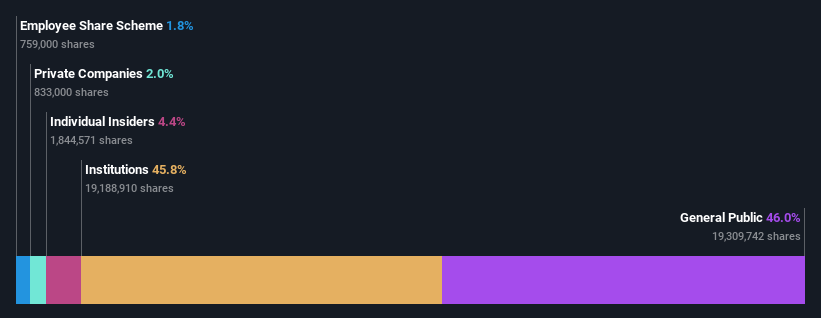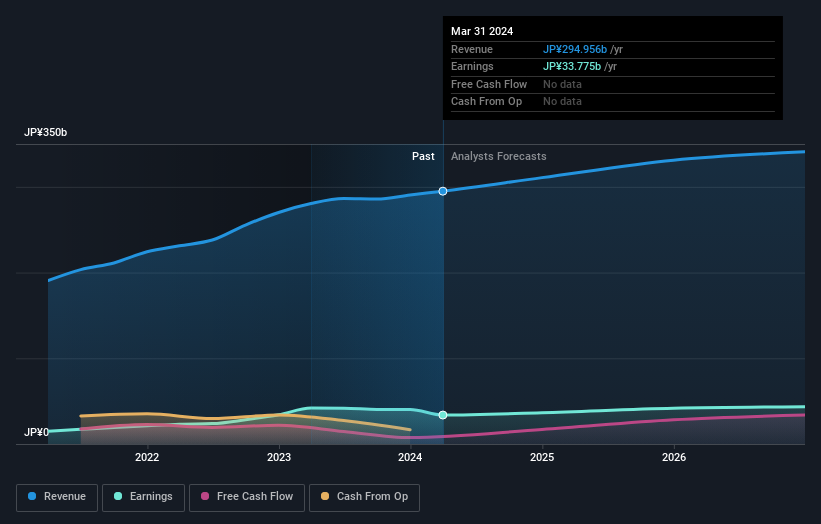- Japan
- /
- Electronic Equipment and Components
- /
- TSE:6856
While institutions own 46% of HORIBA, Ltd. (TSE:6856), retail investors are its largest shareholders with 46% ownership
Key Insights
- Significant control over HORIBA by retail investors implies that the general public has more power to influence management and governance-related decisions
- A total of 25 investors have a majority stake in the company with 46% ownership
- Institutional ownership in HORIBA is 46%
To get a sense of who is truly in control of HORIBA, Ltd. (TSE:6856), it is important to understand the ownership structure of the business. We can see that retail investors own the lion's share in the company with 46% ownership. Put another way, the group faces the maximum upside potential (or downside risk).
And institutions on the other hand have a 46% ownership in the company. Insiders often own a large chunk of younger, smaller, companies while huge companies tend to have institutions as shareholders.
Let's take a closer look to see what the different types of shareholders can tell us about HORIBA.
View our latest analysis for HORIBA

What Does The Institutional Ownership Tell Us About HORIBA?
Many institutions measure their performance against an index that approximates the local market. So they usually pay more attention to companies that are included in major indices.
As you can see, institutional investors have a fair amount of stake in HORIBA. This implies the analysts working for those institutions have looked at the stock and they like it. But just like anyone else, they could be wrong. It is not uncommon to see a big share price drop if two large institutional investors try to sell out of a stock at the same time. So it is worth checking the past earnings trajectory of HORIBA, (below). Of course, keep in mind that there are other factors to consider, too.

Hedge funds don't have many shares in HORIBA. National Mutual Insurance Federation of Agricultural Cooperatives, Asset Management Arm is currently the company's largest shareholder with 4.0% of shares outstanding. Sumitomo Mitsui Trust Asset Management Co., Ltd. is the second largest shareholder owning 3.8% of common stock, and The Vanguard Group, Inc. holds about 3.3% of the company stock.
A deeper look at our ownership data shows that the top 25 shareholders collectively hold less than half of the register, suggesting a large group of small holders where no single shareholder has a majority.
Researching institutional ownership is a good way to gauge and filter a stock's expected performance. The same can be achieved by studying analyst sentiments. There are a reasonable number of analysts covering the stock, so it might be useful to find out their aggregate view on the future.
Insider Ownership Of HORIBA
The definition of company insiders can be subjective and does vary between jurisdictions. Our data reflects individual insiders, capturing board members at the very least. Company management run the business, but the CEO will answer to the board, even if he or she is a member of it.
Insider ownership is positive when it signals leadership are thinking like the true owners of the company. However, high insider ownership can also give immense power to a small group within the company. This can be negative in some circumstances.
We can report that insiders do own shares in HORIBA, Ltd.. The insiders have a meaningful stake worth JP¥24b. Most would see this as a real positive. It is good to see this level of investment by insiders. You can check here to see if those insiders have been buying recently.
General Public Ownership
The general public, who are usually individual investors, hold a 46% stake in HORIBA. While this group can't necessarily call the shots, it can certainly have a real influence on how the company is run.
Next Steps:
I find it very interesting to look at who exactly owns a company. But to truly gain insight, we need to consider other information, too. Consider risks, for instance. Every company has them, and we've spotted 2 warning signs for HORIBA you should know about.
If you would prefer discover what analysts are predicting in terms of future growth, do not miss this free report on analyst forecasts.
NB: Figures in this article are calculated using data from the last twelve months, which refer to the 12-month period ending on the last date of the month the financial statement is dated. This may not be consistent with full year annual report figures.
Valuation is complex, but we're here to simplify it.
Discover if HORIBA might be undervalued or overvalued with our detailed analysis, featuring fair value estimates, potential risks, dividends, insider trades, and its financial condition.
Access Free AnalysisHave feedback on this article? Concerned about the content? Get in touch with us directly. Alternatively, email editorial-team (at) simplywallst.com.
This article by Simply Wall St is general in nature. We provide commentary based on historical data and analyst forecasts only using an unbiased methodology and our articles are not intended to be financial advice. It does not constitute a recommendation to buy or sell any stock, and does not take account of your objectives, or your financial situation. We aim to bring you long-term focused analysis driven by fundamental data. Note that our analysis may not factor in the latest price-sensitive company announcements or qualitative material. Simply Wall St has no position in any stocks mentioned.
About TSE:6856
Flawless balance sheet, good value and pays a dividend.
Similar Companies
Market Insights
Community Narratives





